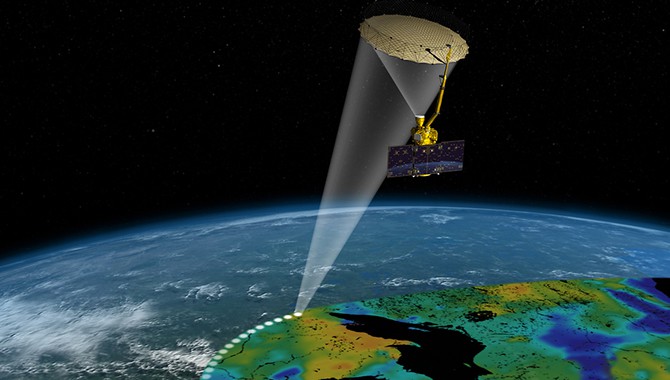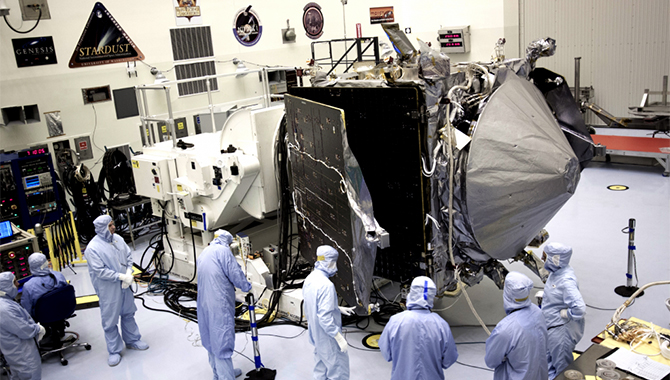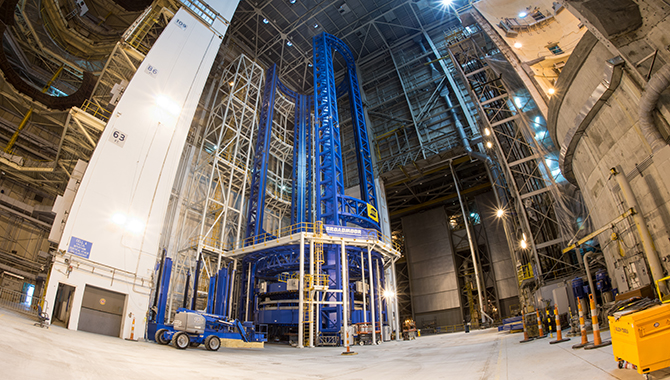
Artist’s impression of the Soil Moisture Active Passive (SMAP) satellite, one of the major projects assessed by the GAO. SMAP launched successfully during the assessment period.
Photo Credit: NASA/JPL-Caltech
A recent GAO report confirmed that cost and schedule growth among NASA’s major acquisition projects remains low compared with previous years.
In 2009, the Government Accountability Office (GAO) was mandated to review selected large-scale NASA programs, projects, and activities to assess the agency’s planning and execution. The GAO’s seventh annual assessment examined three areas: current performance of NASA’s portfolio of large-scale projects, the agency’s approach to developing and maturing critical technologies, and NASA’s efforts to reduce acquisitions risk and strengthen its management of large, complex projects.
Defined as having an estimated life-cycle cost of more than $250 million, the 16 major projects examined by the GAO included 12 in the implementation stage—for which cost and schedule baselines exist—and 4 in the formulation stage.
Projects in the implementation stage included Gravity Recovery and Climate Experiment Follow On (GRACE-FO), Ice, Cloud, and Land Elevation Satellite-2 (ICESat-2), Interior Exploration using Seismic Investigations, Geodesy, and Heat Transport (InSight), James Webb Space Telescope (JWST), Magnetospheric Multiscale (MMS), Orbiting Carbon Observatory 2 (OCO-2), Origins—Spectral Interpretation-Resource Identification-Security-Regolith Explorer (OSIRIS-REx), Soil Moisture Active and Passive (SMAP), Solar Probe Plus (SPP), Space Launch System (SLS), Space Network Ground Segment Sustainment (SGSS), and Transiting Exoplanet Survey Satellite (TESS). Development cost baselines for these projects range from $264 million for GRACE-FO to $7.02 billion for the SLS. Three of the projects—MMS, OCO-2, and SMAP—launched successfully within the assessment period.
The four projects in the formulation stage were Mars 2020, NASA ISRO Synthetic Aperture Radar (NISAR), Orion Multi-Purpose Crew Vehicle, and Surface Water and Ocean Topography (SWOT).
Among the projects, the GAO found that cost and schedule growth remained low, with a total cost growth of 2.4% compared with 3% for the previous year* and an average schedule increase of just three months compared with original baseline schedules.
Cost and schedule growth for the current assessment period was associated with three projects: ICESat-2, MMS, and SGSS. Both ICESat-2 and SGSS required rebaselining after the projects were confirmed. The GAO also noted that two large projects account for more than half of NASA’s major projects portfolio budget: the SLS (37%) and the JWST (33%). Should cost or schedule slippage occur for either program, the entire portfolio could be affected. However, the agency confirmed that these projects are making excellent progress. Furthermore, improvements in NASA’s joint cost and schedule confidence level (JCL) process and adherence to earned value management support better planning and execution of large-scale acquisitions.
Beyond examining NASA’s management of its major projects portfolio, the GAO determined that the agency has significantly improved its approach to maturing critical technology. NASA now matures technology independent of specific projects, which enhances cost effectiveness as the technologies are incorporated into missions. The GAO acknowledged that this practice is associated with risk reduction.
NASA reviewed the GAO report and agreed with its findings overall.
*For both 2014 and 2015, total cost growth was calculated without the JWST.
Read a previous APPEL News Government Brief about the James Webb Space Telescope.









